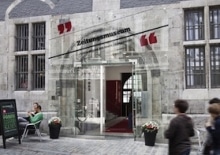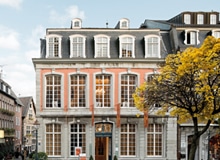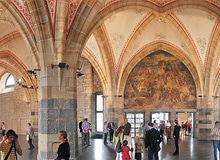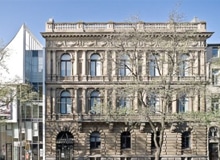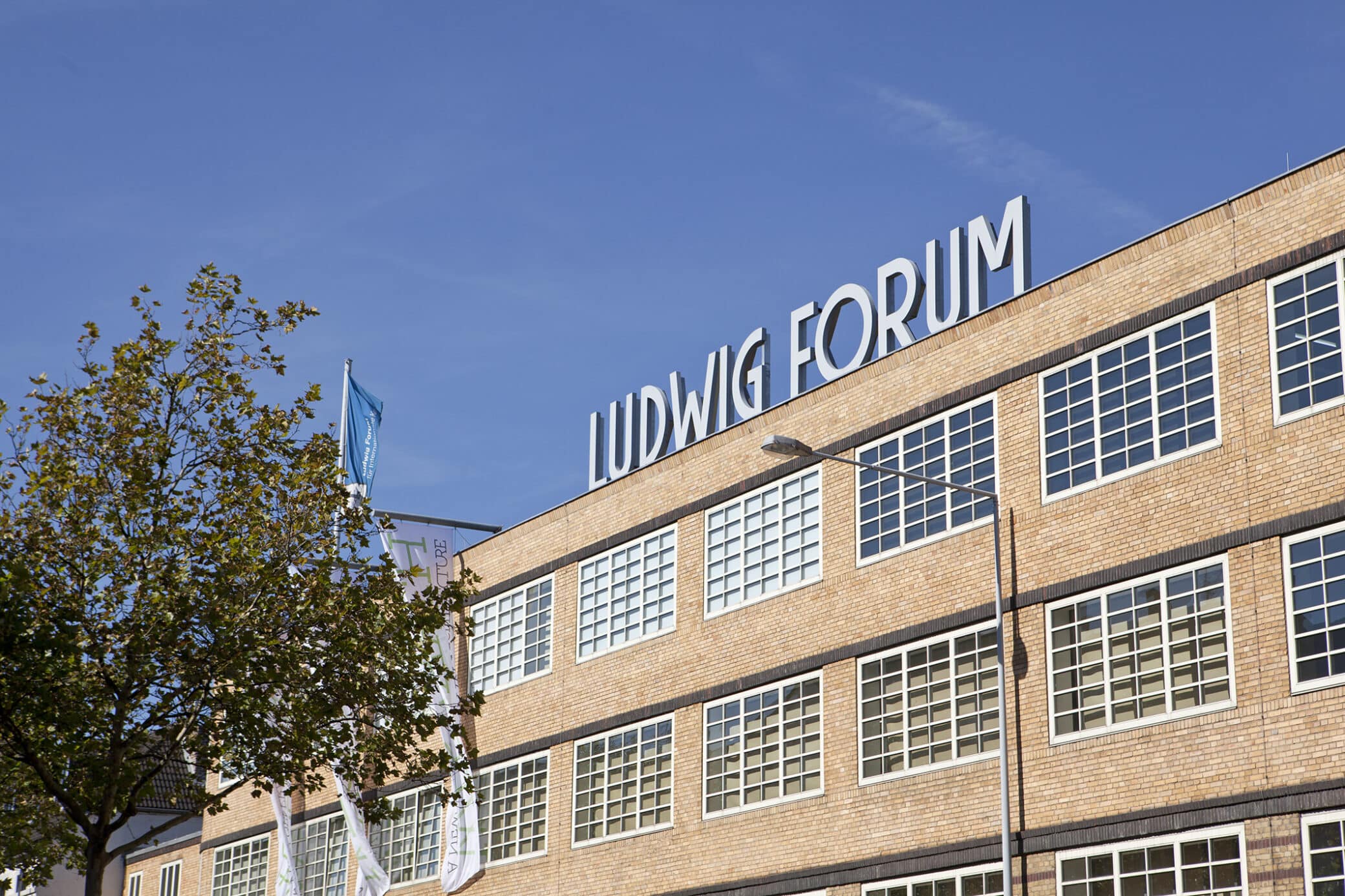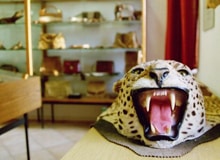Restoration of Duane Hanson’s Supermarket Lady
The Supermarket Lady by Duane Hanson was shown for the first time immediately after its completion at the O.K. Harris Gallery in New York. It was there that the Ludwig couple discovered it in 1970, acquired the sculpture and showed it in Aachen in the Neue Galerie – Ludwig Collection in the spring of the same year. The shopping housewife is one of the central motifs in the oeuvre of the American artist. Again and again he varied this type and worked out above all the tension between a compact core figure and a multitude of seemingly inconsequential things such as shopping bags, goods, or bags. The Supermarket Lady from the Ludwig Collection in Aachen is the first figure from this group of motifs.
Until the late 1980s, the sculpture led an eventful life. It was loaned to numerous renowned houses in Europe. These journeys did not leave it unscathed. Restoration of the sculpture was urgently needed. In 2004, thanks to the generous support of the Peter and Irene Ludwig Foundation, it could be tackled.
The team of restorers consisting of Julia Rief, Christina Sodermanns, Bernadette van Beek (NL), Anna Comiotto (CH), Sandra Ryf (CH) and Kerstin Stickelmann (B) agreed on a procedure that preserved the original materials as much as possible. Numerous chemical and physical examinations were carried out, specialists in plastic restoration were consulted as well as experts from various universities and industrial companies. Representatives from museums, restoration institutes, academia and industry met to discuss the questions posed to them by the Aachen Lady. After two years of work, the Supermarket Lady was able to return to the showroom of the Ludwig Forum.
Restoration protocol
The artwork
The fully plastic female figure of Supermarket Lady is made of glass fiber reinforced polyester resin. Its surface is painted with oil paints. She wears ready-made clothing made of various textiles as well as various accessories made of plastic. Another extensive material complex is the shopping cart. In the shopping cart she pushes in front of her is a wide selection of food packaging, for example, for oatmeal, candy, baking mixes, cookies, margarine, cheese spreads, juice, tea bags, and dog food. There are also egg cartons, boxes for frozen meals, canned vegetables, beverage cans and milk cartons. There are also non-food items such as aluminum foil, cling film, dishwashing liquid, toilet paper, deodorant and bath oil. Most of the packages are empty and carefully sealed. On the other hand, the food items packed in transparent film, such as bread, noodles and coconut slices, are genuine.
Material
There are 79 items in the shopping cart alone; if you add the figure from the headscarf to the shoes, you get more than 100 individual items. There are six categories in total: organic material, textile, plastic, glass, paper and metal. The individual material groups can be further differentiated: “Textile” includes various natural and synthetic fibers. These include viscose (hairnet), Dralon (skirt), nylon (sweater) and cotton (slippers). Plastic” includes materials ranging from polystyrene (curlers) to PVC (handbag).
Damage report
The variety of materials is one reason for the wide range of damage patterns. In addition, the artist chose some items, such as patent leather bags or plastic food wrappers, that have relatively rarely found their way into artistic treatment. In these cases, therefore, there was no restorative experience to fall back on. 26 different types of damage were noted. Among other things, there was surface dirt, fading of the imprints, cracks, scratches, missing parts, creases, and large amounts of a brown glue that the artist presumably used to secure the contents of the car against theft. This glue had darkened considerably, so that it was disturbingly obvious, especially in contrast to the faded colors of the packaging.
The Supermarket Lady had suffered the first serious damage in 1975, when her right leg broke off. The artist was then invited to come to Aachen and repair the damage. However, he was not content with merely gluing and supplementing the fracture; he also repainted the “skin surface” of the figure and added more bruises and shadows so that she appeared older overall. Hanson justified the redesign by saying that he, too, had aged.
The particular stress on the hand when it rested on the shopping cart handle eventually caused the thumb of the left hand to break off in 1987. That same year, the figure was severely damaged a second time when it fell over backwards during an exhibition set-up, sustaining a deep fracture at the base of its neck. The origin of the cracks on the left shoulder under the blouse, on the elbows, on her left ankle, on the head below the hairline and in the area of the right ear could not be dated in retrospect. Due to these instances of damage, it was decided not to allow the sculpture to travel.
Nevertheless, further changes occurred over the years: The paint layer on the elbows and hands had worn away in places. The curlers, which had become brittle, had partially come loose from the hair and were hanging down, resulting in an overall rather unkempt appearance. This problem could initially be remedied by replacing the better-preserved curlers, which were hidden by the headscarf, with the defective pieces.
As for the shopping cart, here too there have been small changes and clear signs of aging through the decades. The arrangement in the upper section has changed slightly several times. Some packages were lost, others were rearranged. For example, a light-colored box that was apparently still on top in New York did not make it to Aachen. Later, a magazine, an orange juice can and a jam jar went missing. The box of “Vienna Dream Bars” changed places from “Mallomars” to “Loft Candy” and back again. The cream spray bottle was also originally on the side and only later at the back of the cart.
As early as the 1980s, restoration condition reports indicated that various wrappings were creased and faded. This condition continued to deteriorate through 2003. Although dust and surface cleaning was undertaken in 1991 and 1995, financial resources were lacking for major restoration projects that would have fundamentally improved the condition of the figure. However, because urgent action was needed, conservator Julia Rief initiated the first comprehensive material examination of Supermarket Lady in 1995. As part of her thesis, Truus Joosten, a restoration student in Maastricht at the time, began an initial survey of the Supermarket Lady‘s damage. She had her material samples of the figure and clothing collected on site analyzed by Thea van Oosten of the ICN, Instituut Collectie Nederland in Amsterdam (then Centraal Laboratorium voor Onderzoek van Voorwerpen van Kunst en Wetenschap). At the same time, she also contacted the artist himself and recorded his restoration ideas by means of a questionnaire. Before the procedure could be finally clarified, the artist died in 1996, but the correspondence with him was invaluable in further planning.
Since the results of the examination had shown that the figure, as well as the packaging, suffered primarily from exposure to sunlight, the sculpture was displayed in a UV-protective showcase from 1995 onwards as a first aid measure. Nevertheless, the fading of the packaging could not be stopped and the condition deteriorated dramatically. In 2003, restoration could finally begin, as Prof. Dr. Irene Ludwig provided a generous sum for conservation and restoration.
Rescue measures
After the inventory, a series of material analyses and tests were performed. Partial results were available through the work of Truus Joosten in 1995. New analyses as a basis for further measures could only be commissioned in 2003, after basic funding had been secured.
From the very beginning, the project cooperated with colleagues from other museums and specialists from various restoration institutes in order to exchange experiences and research results or to experiment with different methods together. Speakers presented the results to the public in a symposium at the Ludwig Forum in order to discuss the most sensible restoration concept:
Thea van Oosten, ICN/Instituut Collectie Nederland, Amsterdam, spoke about her material analyses on the shopping cart packaging. Bernadette van Beek and Marieke Kraan (both KOP Papierrestauratie, Arnhem) reported on their preliminary condition investigations regarding the contents of the shopping cart. Petra Mandt and Kim Ohm, graduate conservators at the Museum Ludwig in Cologne, summarized the experiences made in Cologne with the artist and the restoration of the Hanson sculpture there. Dr. Helen van Westgeest (lecturer at the University of Leiden and Amsterdam), Letitia van Gemert (Radboud University, Nijmegen) and the curator of the Ludwig Forum, Dr. Annette Lagler, presented art historical arguments. In the discussion that followed, the artist’s opinion also played an essential role. In 1995, Hanson had made what conservators would consider a bold proposal to completely replace the contents of the shopping cart and fill it with brand new products. Similar to his overpainting of the Supermarket Lady from 1975 or the renewal in the Woman with Handbag from the Cologne collection in 1977 and 1990, his interventions and ideas were artistically intended without attaching particular importance to historical content. However, Hanson’s idea was rejected for legal and aesthetic reasons: On the one hand, originality and the associated value would no longer have been guaranteed; on the other hand, the design of the packaging had changed considerably in the meantime and the coherent overall appearance would have been destroyed. For these reasons, the idea of replacing goods with facsimiles or copies that would have reproduced the original condition was also not pursued further. Naturally, the restorers were keen to preserve as much of the original substance as possible, even when it came to packaging, i.e. ephemeral disposable products. It was therefore decided to replace only those parts in the shopping cart whose degree of destruction made restoration impossible. These included the completely broken bread, the bag of noodles and the foil wrappings of bread and coconut slices. In these cases, a reconstructed prototype was made in the hope that new film restoration techniques would make it possible to work on the torn bags in the future. The remaining original wrappings were to be smoothed and stabilized, and the faded sections were to be supplemented by retouching and thus visually enhanced. Marieke Kraan (KOP Papierrestauratie, Arnhem) was entrusted with the inventory of the damage to the cardboard and paper packaging, while Bernadette van Beek (KOP Papierrestauratie, Arnhem) was responsible for the restoration of the paper objects.
In the case of the figure, it was decided to remove the overpaintings and overpastings of previous restorations and to supplement the missing areas with minimal retouching. It was agreed that the figure and its clothing and accessories would be carefully cleaned. The general premise was to preserve the visual balance between the figure and the carriage. Subsequently, other specialists were brought in who could identify with the code: Kerstin Stickelmann (painting conservator, graduate of the École Nationale Supérieure des Arts Visuels de la Cambre, Brussels) was predestined to restore the surface of the sculpture due to her experience with the painting layer structure on the Supermarket Lady. Anna Comiotto (graduate of the Bern University of the Arts) took on the restoration of the handbag based on her knowledge of painting layers on plastic. Sandra Ryf (graduate of the Bern University of the Arts) was entrusted with the reconstruction of the bread bag because of her knowledge of printing techniques on plastic films. Carsten Grohnloh (media designer, Fotocom Aachen) produced print templates from the plastic packaging that could not be restored.
Even if a return to the original state of the figure was not possible due to the partially severe decay of the materials, the restoration was to approximate the original artistic intention as closely as possible. Precisely because the restoration of the Supermarket Lady was a difficult project that required a great deal of sensitivity and represented a constant balancing act between preservation and renewal, the public was kept up to date programmatically via press releases and show restorations.



